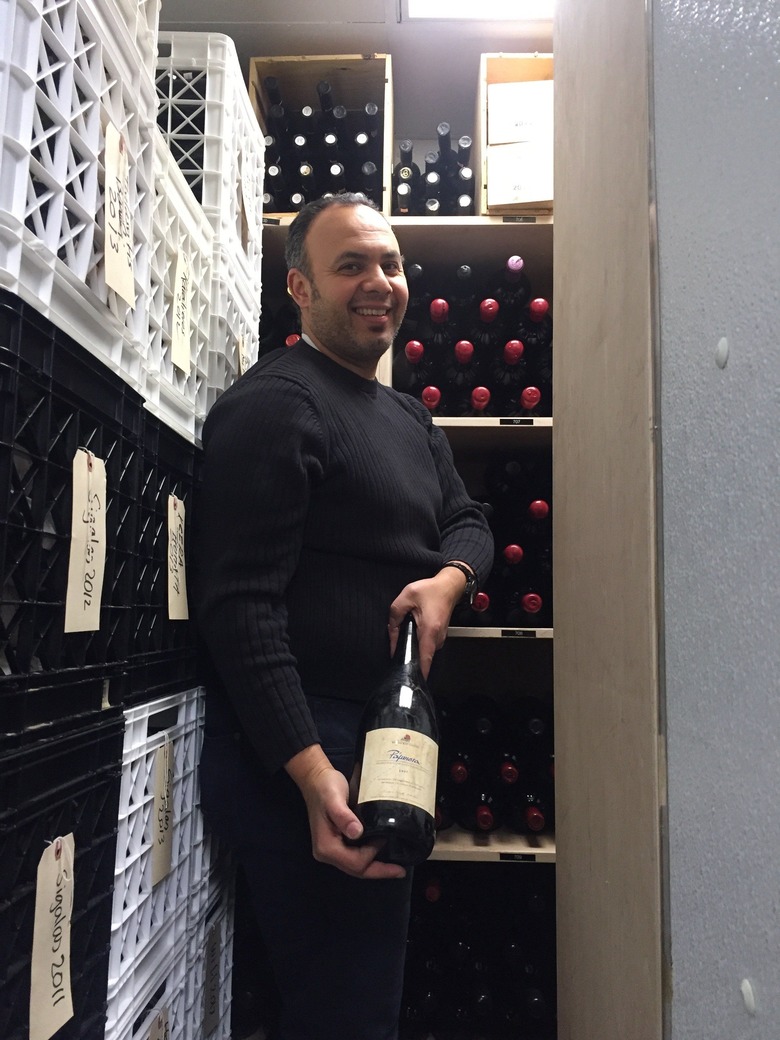A World Of Greek Wine In Midtown Manhattan
In a small, well-stocked cellar on Manhattan's Seventh Avenue, just a few blocks south of Central Park, beneath the sprawling, business-cozy Greek restaurant Molyvos, lies one of the greatest compilations of modern Greek wine. The restaurant's general manager, Kamal Kouiri, gathered and watches over each bottle, all of them available to be poured for diners. "New Yorkers like to taste something different and unique," Kouiri says of his list, which transforms his restaurant into a stateside tour of Greece and its wines. Molyvos opened in 2000, Kouiri joined the team in 2001, and by 2007, he had turned its list 100 percent Greek.
Kouiri arrived in New York City 27 years ago from Morocco and landed a busboy position at the now-closed Hanratty's Restaurant in East Harlem. Eventually becoming manager, he oversaw the wine list, which included the standard French and Italian labels as well as a Greek one or two — not inspired by the American menu but because the owner was a Cyprus ex-pat. Those bottles started Kouiri on an unexpected track. "I'm sure there's good Greek wine," was his reaction after tasting them.
In the name of research, he set off for Greece, stopping first at the island of Santorini and tasting its crisp white wines made from the native assyrtiko grape. He returned to Greece regularly over the years, stocking up in New York from importers' lists that still grouped Greek bottles under the catch-all heading "Mediterranean wines." While honing his palate, he watched Greek wines improve and become better known — and more widely available.
The Greek climate has supported vines and winemaking for at least 6,000 years: by turns hot, dry, and cold; near a sea at all points (Aegean, Ionian, Libyan); and mostly mountainous. Crete and the gorgeously volcanic, wind-battered current-day Santorini were likely the country's first commercial wine centers 30 centuries ago. After thriving through Classical Greece through the Roman and early Byzantium eras, Greek wine production began a steady centuries-long downturn halfway through the second millennium. Heavy taxes levied by Ottoman rulers, the razing of vineyards during the 1821 Independence War against that empire, the ensuing poverty of a newly independent nation....By the time the 20th century began, little remained of Greek wine in either quantity or quality.
Today, through an elaborate blend of vineyard development, repopulated cities, and hard work around branding, quality production, and terroir identity, Greek wine is bouncing back. Kouiri calls vintage, terroir, and savoir faire as the three pillars of modern-day Greek winemaking. "Wine should show the vineyard, the grape evaluation. That's why it's important to look at the vintage. Maybe it was hard, maybe it was rainy. But look at what the winemaker did," he says. Greek wine is a well-considered partnership between the vineyard and the winemaker. The 20 or so international varieties grown throughout the country are prized not only for their ability to express their locations, but also because they work so well with the approximately 60 native Greek varieties when it comes to blends.
Kouiri knows his proudest acquisition: a run of Ktima Pavlidis Winery's Thema. The wine blends Greek agiorgitik, a dark-skinned, intensely berry-flavored grape, capable of styles from gulpable juicy wines to seriously age-worthy ones, and an international variety, syrah, made by now-lauded winemaker Nikos Karatzas, from grapes grown in the foothills of Mount Falakro in Drama in northeast Greece, nestled between Bulgaria and the Aegean Sea. Thema has been on Kouiri's wine list since 2005, the first year Karatzas made wine, and holds strong there through the latest release, 2013.
France's cabernet sauvignon and Italy's nebbiolo) are grown nowhere else. The wines can span several vintages like Ktima Kir Yianni's Ramnista, made from old-vine high-acidity dark-skinned xinomavro grapes in the Naoussa appellation in Northern Greece near Macedonia, and aged in barrel and bottle for two years before release.
Also from Naoussa is one of Greece's oldest wineries, Boutari, a pioneer in Greek red wine made from xinomavro and rosé and sparkling wine from the pink-skinned native moschofilero, which its founders grew in the Peloponnese Islands appellation Mantinia. Examples from both can be found on Molyvos list. And there are bottles of moschofilero blended with another pink-skinned Greek grape, roditis, by Gaia, one producer whose true-to-terroir efforts include a wild-ferment assyrtiko — which allows yeasts naturally present in the vineyard and winery to go to work eating grape sugars (and making alcohol and flavors in return) rather than handing that job over to bought, pre-selected yeast likely from somewhere else — and also underwater aging: Cool, humid, and free of air-borne oxygen, the sea offers seemingly perfect wine-aging conditions.
"I'm in love with this wine," Kouiri says of another Greek holding: Alpha One from Alpha Estate. The vineyard has been making wines in Amyndeon in northwestern Greece near Macedonia, its vineyards planted more than 2,000 feet above sea level with a mix of grapes both Greek and international — xinomavro; dark-colored, tannic mavrodaphne; pinot noir; barbera; and chardonnay among them. The Alpha One is big and complex, unfiltered and aged in both barrel and bottle before being released four-and-a-half years after the grapes are harvested, And in each year's bottles? It's winemaker's choice: every year Alpha oenologist Angelos Iatridis chooses the grapes he deems best express this cold-winter, dry-summer, clay-chalk-soil terroir under that vintage's specific weather conditions. Not a lot of this wine gets made. Along with blend components, quantities vary too: in 2009 there were just two barrels produced. For a taste of Iatridis's take on native varietal wine, there's Alpha Xinomavro Reserve Vieilles Vignes, all old-vine xinomavro. That the grape's name translates to "black acid" is a robust indicator of what you're getting: brightness and lots of tannins (good for both edge and aging). "I see xinomavro as an investment," says Kouiri. It's also smart spending for diners ordering tableside in New York City; it appears on his list at $100 to $180 a bottle.
For outliers, there's the usually maligned, often rightly so, retsina — a classic Greek wine based on what was once a necessary preservation technique: sealing wine containers with resin, which unavoidably imparted its strong aromas to the wine. The style persevered in spite of technological updates, but, explains Kouiri, "for a long time retsina was bad wine covered by resin flavors." Now, there are well-made wines destined for retsina. Papagiannakos Winery near Athens on the Mesogaia plain where mainland Greece reaches south into the surrounding seas —said to be where Greek wine god Dionysus roamed — makes a crisp, modern style, lemony and resin-y at once, from pale-skinned savatiano, the Greek grape grown most throughout the country and traditionally slated for retsina. The classic style, Kouiri explains, relies on a ratio of 1 kilogram of resin per ton of grapes; today's zippier recipe cuts the resin by almost two-thirds, down to 350 grams per ton of grapes. Where both the grape and the style can go wrong in other hands, Papagiannakos is widely recognized as coaxing both to their best and relies on 50-year-old vines to do so.
There's another other classic, too: Vinsanto, the sweet wine of Santorini, made from sun-dried assyrtiko grapes (with the occasional help of native grapes athiri and aidani), aged for years, with the top-crafted ones capable of lasting for decades and longer. In a range of vintages from 1984 to 2008, vinsanto is one of Kouiri's focuses.
Dry assyrtiko is, too. It's Greece's champion grape, as capable of becoming fresh, crisp, salty-lemon wines meant for drinking young as it is of being crafted into long-ageable savory, honey-aroma-ed wines. The Molyvos cellar has a full assyrtiko section, dedicated to the full range of the grape's possibilities, from young to aged, from still to sparkling to sweet.
To understand how the Greek wine scene all began, start with a quality retsina. Kouiri says, "Go back 4,000 years, see how wine was made and wine as daily life, then see the Greek struggle through the past 500 years, economic and otherwise," In the 1970s, Greece adopted its current appellation system, which identifies 28 specific regions. There's a sparkling brut xinomavro from Domaine Karania in the Florina appellation on his list, as well as a floral, spicy sparkling moschofilero from Mantinia, an area dominated by that grape. Next up, a still white made from the rose- and lychee-scented malagousia grape — "It's the new assyrtiko," notes Kouiri, recommending Alpha Ktíma's single-vineyard varietal bottle — then turn to something more robust: "Greece for me makes the best sweet wine," says Kouiri. A vinsanto, sure, but other options include Aegean island muscat from Samos (muscat à petits grains), with grapey, rose-y aromas, and Lemnos, made of dried zibibbo — the local synonym for muscat of Alexandria — grapes.
For the wine-drinker looking for a shorter survey? For the uninitiated, Kouiri recommends a young Santorini assyrtiko, "clean, fresh, and drinks like a good sancerre, albariño, or chablis," and, for red, a Peloponnesian agiorgitiko. Gaia's, says Kouiri, is "sexy, round, with cherry and licorice, and tannins." For those with some Greek wine background already, or those ready to take a bold leap, there's Santorini assyrtiko again, this time in the powerful Nychteri style — "late harvest, preserved in ancient barrels, big, lush, roasted peach and nectarine, and comparable to a Chassagne-Montrachet" — from Domaine Sigalas. For red, there's xinomavro — from the PDOs, or quality regions, of Naoussa or Rapsani — complex, tasting of place.
If there's an "always" in a winemaking place with such variation in materials and landscape, it seems fair to say that with Greek wine there's always saltiness, there's always an herbal note, and there's always something savory, from the freshest white to the meatiest red. It wouldn't be off base to to notice basil, mint, lemon, and rose petals with some frequency. "All vineyards are within proximity to the sea," say Kouiri of this primarily maritime-climate nation graced with sea spray that reaches into the vineyards relentlessly, giving them an unmistakable tang. It's a saline zinginess meant for food. "Rich in acid, from light- to full-bodied," Greek wines, Kouiri points out, go with all types of dishes — the mineral-laden rosés make especially good partners for pizza and pasta dishes. Add to their virtues that, at least before too many others catch on, they're good value.

